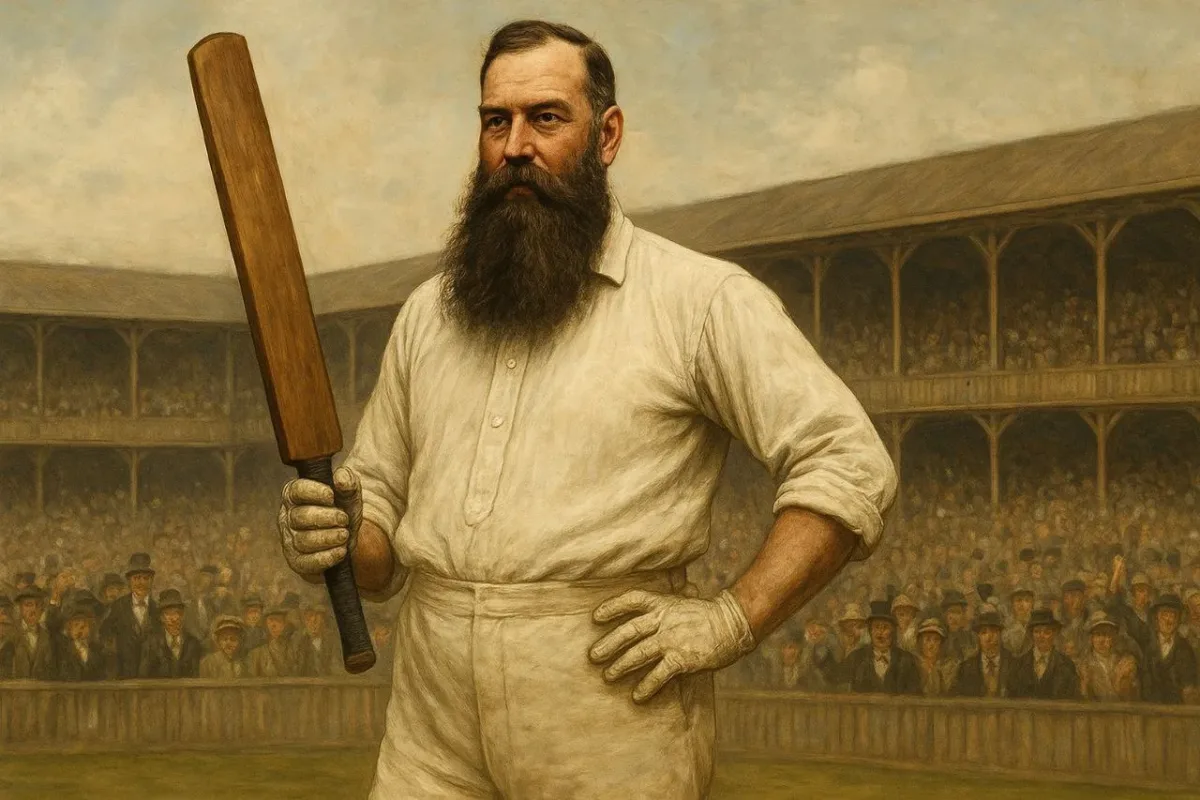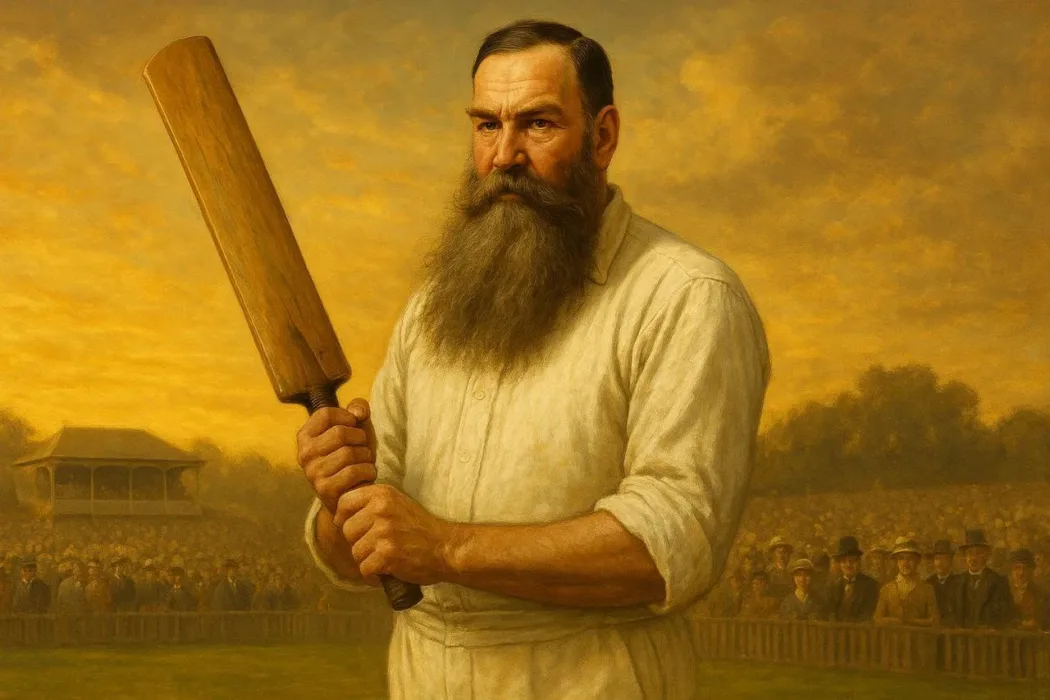Cricket has given the world countless legends, but only a few shaped the game at its roots. Among them stands a man whose legacy continues to define cricket’s identity.
Fans often ask, “Who is the Godfather of Cricket?” The answer takes us back to the 19th century, to a larger-than-life figure—W.G. Grace. This article explores his biography, career, and why he holds the timeless title of the Godfather of Cricket.
Table of Contents
Toggle
The phrase “Godfather of Cricket” is not an official award. Instead, it is an honorary title given to the player who built the sport’s foundation. Cricket in the early 1800s was far from the professional, global game we see today. Rules were incomplete, pitches were uneven, and the sport lacked mass popularity.
It was during this period that W.G. Grace emerged. His dominance with bat and ball transformed cricket into a recognised sport, one loved by fans and respected by players. The term Godfather of Cricket belongs to him because he set the standards that shaped modern cricket.
The Godfather of Cricket is William Gilbert Grace, famously known as W.G. Grace. Born on 18 July 1848 in Gloucestershire, England, Grace came from a cricketing family. His brothers E.M. Grace and Fred Grace also played at the highest level, but none matched W.G.’s impact.
Grace’s cricketing journey lasted more than forty years, starting in the 1860s and continuing into the 1900s. He played for Gloucestershire, Marylebone Cricket Club (MCC), and London County, and represented England in twenty-two Test matches between 1880 and 1899. His long career allowed him to witness and influence cricket’s early growth.
W.G. Grace was not just a batsman. He was an all-rounder who dominated every aspect of the game. He scored 54,211 first-class runs and took 2,809 wickets, achievements that remain astonishing given the poor conditions of pitches and equipment at the time. He also scored 126 centuries, setting the trend for future batting greats.

Beyond numbers, Grace’s presence turned cricket into a true spectator sport. Crowds filled stadiums to watch him bat, newspapers published his scores with pride, and he became one of the first global sporting icons. His iconic beard, towering personality, and unique style made him unforgettable.
For these reasons, cricket historians and fans worldwide call him the Godfather of Cricket. He was not only a record-breaker but also a pioneer who gave cricket its identity as a professional sport.
William Gilbert Grace, born on 18 July 1848 in Downend, Gloucestershire, was one of the most influential figures in cricket history. He came from a family deeply involved in the sport, but his skills, leadership, and achievements placed him above the rest. He balanced his cricket career with his profession as a physician, earning respect as both a sportsman and a doctor.
Grace died on 23 October 1915 in Mottingham, London, leaving behind a legacy that continues to inspire cricket lovers. Known for his long beard and commanding personality, he was one of the first sportsmen to achieve celebrity status. He played for Gloucestershire for most of his career, also representing MCC and London County, while his impact reached far beyond county boundaries.
W.G. Grace is remembered not only for his incredible records but also for the way he changed cricket. He introduced new techniques in batting, such as front-foot play and aggressive stroke-making, which became the foundation of modern batting. He was the first to make cricket not just a contest between players but also an entertainment for the masses. His ability to score runs under challenging conditions proved that cricket could be played with both skill and style.
Grace also drew large crowds wherever he played, making cricket a popular spectator event for the first time. His leadership on the field inspired fellow players and set an example of how professionalism could exist within a gentleman’s game. He was instrumental in raising the standard of competitions, which pushed cricket boards to organise tournaments in a structured format.
Achievement | Record/Stat |
First-Class Matches Played | 870 |
First-Class Runs | 54211 |
First-Class Wickets | 2809 |
Test Matches | 22 |
Notable Innovation | Modern batting techniques |
Legacy | Recognised as “Godfather of Cricket” |
Grace was more than a cricketer. He was the symbol of cricket’s rise. His presence on the field captured public imagination and gave the sport an identity. He batted in an era when conditions were unpredictable and equipment was minimal, yet he managed to dominate bowlers with confidence and style.
His leadership helped Gloucestershire become one of the strongest county teams of the time. His personality also contributed to the popularity of the sport. A famous anecdote recalls him being bowled out early in an innings. Instead of leaving, he replaced the bails and told the bowler, “They came to see me bat, not you bowl.” Such moments reflect his humour and his status as cricket’s first superstar.
Although W.G. Grace is universally recognised as the Godfather of Cricket, modern fans sometimes associate the title with other legends. Sir Don Bradman, with his extraordinary batting average of 99.94, is often described as the greatest batsman ever. Sachin Tendulkar, adored worldwide, is widely called the “God of Cricket.” In some regions, passionate fans even use the term Godfather to describe their local heroes.
However, history remains clear. The original and true Godfather of Cricket is W.G. Grace. His achievements, influence, and pioneering role cannot be replaced by any other cricketer.
The legacy of W.G. Grace goes far beyond statistics. He changed the way cricket was played, watched, and celebrated. His batting inspired future generations, including legends like Don Bradman, Viv Richards, and Sachin Tendulkar. His presence on the field brought cricket into the hearts of people and helped make it England’s national sport.
Grace’s influence encouraged cricket boards to introduce more structured competitions, laying the groundwork for the professional tournaments we see today. His charisma also brought cricket closer to culture, making it more than just a game. His contribution gave cricket an identity that still shapes the sport across the world.
The Godfather of Cricket is W.G. Grace, the man who gave the sport its structure, style, and spirit. His achievements on the field, his charisma off it, and his vision for cricket’s future shaped the game forever. He remains the pioneer who transformed cricket from a gentleman’s pastime into a professional sport admired worldwide.
When fans ask, “Who is the Godfather of Cricket?” the answer is simple. It is W.G. Grace, the legend whose legacy still echoes in every cricket ground today.
Who is the Godfather of Cricket?
The Godfather of Cricket is W.G. Grace, the 19th-century legend who shaped the foundation of modern cricket.
Why is W.G. Grace called the Godfather of Cricket?
He introduced modern batting techniques, inspired professionalism, and made cricket a popular spectator sport.
Is Sachin Tendulkar the Godfather of Cricket?
No. Sachin Tendulkar is called the “God of Cricket,” while W.G. Grace is known as the Godfather.
What were W.G. Grace’s records?
He scored 54,896 first-class runs, took 2,876 wickets, and played more than 870 first-class matches.
How did W.G. Grace change cricket?
He revolutionised batting, attracted large crowds, and turned cricket into a professional and cultural phenomenon.

I’m Avijit Brahma, a cricket enthusiast who enjoys dissecting games, evaluating player performances, and offering my opinions on the sport. I’m here to share my thoughts, ideas, and everything about cricket, whether it’s a thrilling finish or a knock that breaks records. Let’s have a proper conversation about cricket!